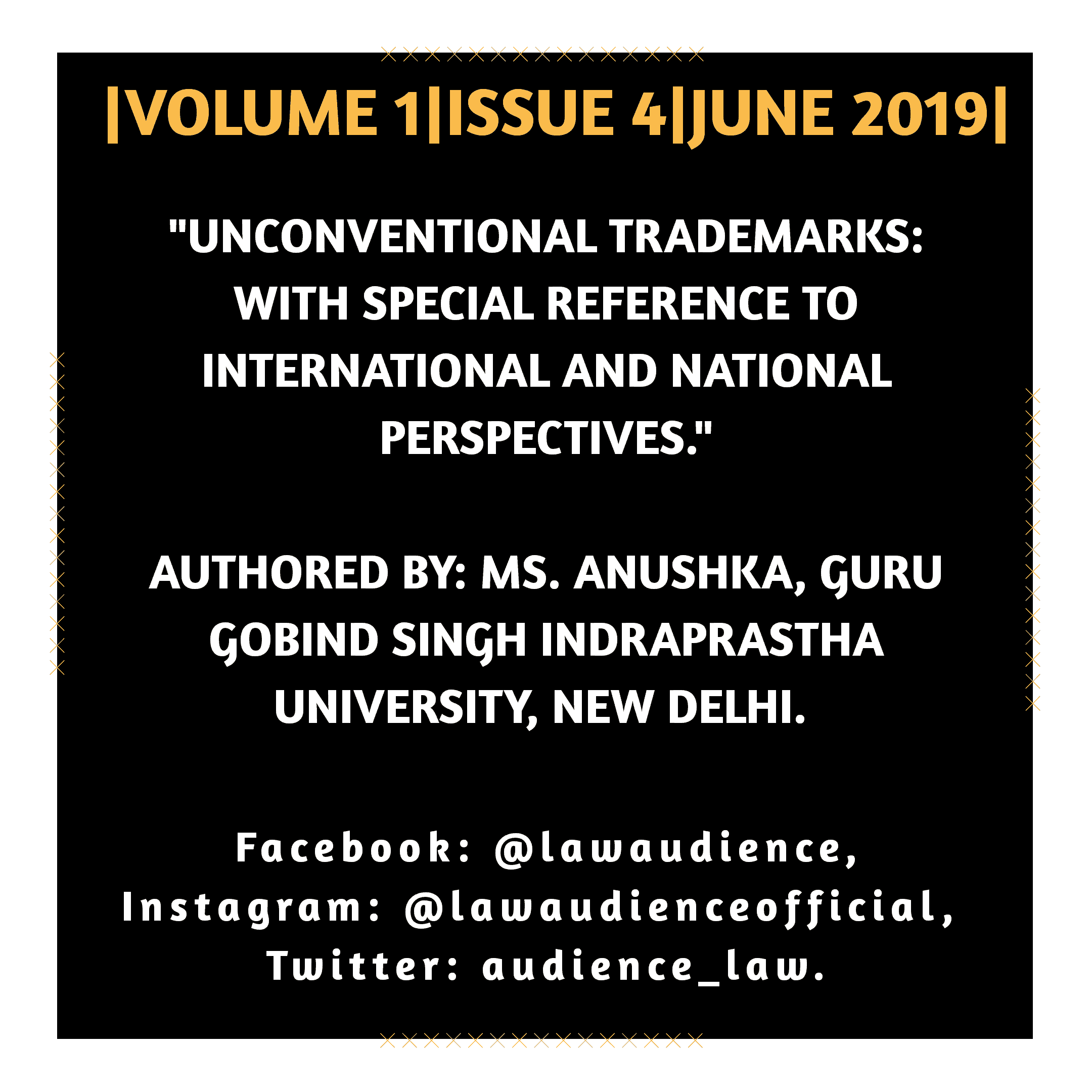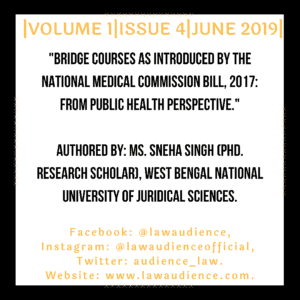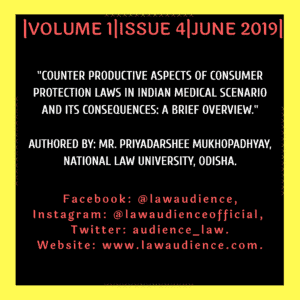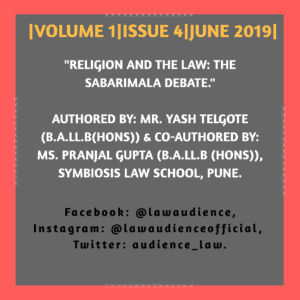Authored By: Ms. Anushka, Guru Gobind Singh Indraprastha University, New Delhi.
I. ABSTRACT:
“This paper deals with the position of unconventional trademark around the globe and in India. Unconventional Trademarks are those marks which have the ability of sound, taste, smell, motion etc. and it also possesses the ability to be distinctive from the goods of another person. The unconventional trademarks should indicate the origin and differentiate the goods from the others. This paper put emphasis on the current situation regarding the registration of unconventional trademarks in the United States, United Kingdom and India. This paper further distinguishes the types of trademark and its registration. Some of the prominent cases have been discussed in this paper including Shield Mark case, Sieckmann Case, etc. Indian Law regarding trademark has been examined and how the laws of trademark apply to unconventional trademark. The paper further put emphasis on the registration of an unconventional trademark.”
II. INTRODUCTION:
A ‘mark’ according to the Trademark Act, 1999 has been defined as a Mark which constitutes a device, heading, ticket, signature, letter, shape of goods, brand, label, name, word, numeral, combination and packaging of colors or includes any other combinations.[1] And Trademark is defined as a mark which is capable of representing graphically and is further capable of differentiating the goods and services of an individual from that of the other and also includes a combination of colors, packaging and shape of goods.[2]
The field of IPR has marked a lot of growth in recent times, and that too with regard to the trademark. The TRIPS has recognized various types of trademarks. In order to adhere to the provisions of the TRIPS, it is necessary for India to make laws regarding it. However, there exist some unconventional trademarks that lie outside the arena of trademark laws both at the National and International Level.
Though, it is noteworthy to see how India is keeping its pace with the trademark laws with the time. This article will put emphasis on unconventional trademark and its position all around the globe.
III. MEANING OF UNCONVENTIONAL TRADEMARKS:
Normally we define Trademark as those marks which differentiate the product from another and identify the origin of the said product. Trademark can be in words, in numeric form or in device form etc. They are also known as conventional trademarks. Some examples of conventional marks are device marks, wordmark, logos, slogans, etc. However, Unconventional Trademarks are those marks which have the ability of sound, taste, smell, motion etc. and it also possesses the ability to be distinctive from the goods of another person. The unconventional trademarks should indicate the origin and differentiate the goods from the others.
The new Trademarks Rules, 2017 along with the Trademarks Act, 1999 has accepted sound as a trademark. Though taste, motion, smell, etc. are not expressly considered as the trademarks. However, if they contain a distinctive category and be able to represent graphically then they get the status of the trademark in India. The concept of an unconventional trademark is at its developing stage and requires many precedents to come to identify it as codified law.
If any trademark is registered, it helps to insert confidence in the consumer and helps to prevent the confusion that may arise in the mind of the consumers. Consumers rely on the trademark to inspect to determine the quality and goodwill.
The need for registration of the unconventional trademark is because the companies and firms want to advertise and design their products in order to appeals to the aesthetic of the consumer. However, Unconventional Trademark can get protection under trademark but there lie some problems which needed to checked and discussed.
IV. SOME ESSENTIALS OF A VALID TRADEMARK:
To get protection under the Indian Trademark Act, 1999, the followings essential are needed to be satisfied:
- It should be a mark under Section 2(1)(m)[3] which states “mark” includes a device, brand, heading, label, ticket, name, signature, word, letter, numeral, shape of goods, packaging or combination of colors or any combination thereof”.
- It should be capable of represented graphically[4].
- The trademark should be distinctive.
It may be class dependent – This may be acquired wholly to one or more specified colors and this combination of colors may become distinctive in nature.
Or maybe inherent or acquired- it means the mark is distinct in itself from everything else and no one can justifiably claim the right to use it. It means distinctiveness through use e.g., Hawkings and luxon etc.
IV.I A GENERAL OVERVIEW OF GRAPHICAL REPRESENTATION:
To get register the trademark, it is required for it to be graphically represented as mentioned in Section 2(1)(zb) of the Indian Trademark Act, 1999. The word ‘graphically represented’ means that any mark which is capable of being published in the journal and register in physical form.[5] It shows the fixed point of reference, indicating what the mark really is.
In the case of Swizzels Matlow Ltd Application No 2,[6] in this, the court gave two reasons for the criterion of mark to be graphically represented:
- to enable the traders in order to identify that what the other traders, carrying out the same form of business has submitted an application for registration of the trademark and also for which product.
- to help the public to identify the sign or label which forms the main subject of registration of the trademark.
It is to note that graphical representation is considered to be objective criteria due to the reason for the degree of precision that will result in it being identifiable. However, According to the provisions mentioned in the Act makes it apparent that the representation must be enough to permit the effective and full implementation of the trademark. The rights and liabilities mentioned in the Act could be realized if the graphical representation will disclose the identity of any sign which it desires to represent.
The question arises regarding the mark being graphically represented or not, which are restricted in with some guidelines in the United Kingdom.
Therefore, a mark can be represented graphically if it fulfils the following criteria.[7]
- It is possible to identify a mark without any need for supporting examples;
- The graphical representation has the ability to replace the mark itself;
- Any person reading trademark journal or inspecting the trademarks register can able to comprehend the nature of a trademark by seeing its graphical representation. So it is important when submitting any musical notation, colors standards, or scientific measurements must be precise and be practically reasonable for the user to clearly understand the mark. Also, it should be able to compare the signs accurately.
However, the guidelines mentioned above are not applicable to the Indian context but provides an insight into how graphical representation should be constructed. It has to be liberally interpreted to make it work with unconventional trademarks in India. It is also important to keep in mind the legislative purpose of laying down the test for graphical representation instead of using visual perceptivity as used in the TRIPS.[8]
Graphical representation should also be in the context of the provisions mentioned in the Act. Rule 2(1)(k) of 2002 trademark rules states graphical representation as a representation of the trademark in the paper form. It clears the air that any representation of the trademarks must be on the paper with the registration application along with the prescribed forms.
V. TYPES OF UNCONVENTIONAL TRADEMARKS AND ITS REGISTRATION PROCESS:
a) SMELL MARKS:
The position of smell marks in the United Kingdom started from the case of Sieckmann vs. Deutsches Patent-und Markenamt[9], where it was held the visual perception is not required for a mark to be represented graphically. The ECJ held that as per the legal requirements the odour cannot be represented graphically to constitute a trademark. The court also observed that the description of the odour is graphically represented but it is not precise, sufficiently clear or objective.
The ECJ also rejected the application of registration of the trademark of the scent of strawberry in a shaving cream and it was rejected on the basis of the want of representation graphically in Eden v. OHIM.[10]Further in the R v. John Lewis[11], where the UK court did not accept the verbal representation of ‘aroma and essence of cinnamon’ for a furniture to be enough to make graphical representation.
However, in VenootschapOnderFirmaSenta Aromatic Marketing’s Application[12], A trademark registered ‘smell of fresh cut grass for the tennis ball’ as a smell mark and also the odour of a beer of dark flight.
The Position of smell marks in the United States is that the Trademark Manual of Examining Procedure presents that smell marks and sound marks cannot be graphically represented but they can be described in a detailed written description. The court has recognized a smell mark in Re Celia Clarke[13], where the essential ingredient of a product is its smell. In this case, the scent was comparable to the colors and hence it was registerable.
b) SOUND MARKS:
Sound Marks can become a sign of distinctive characters. Although it can be inherently distinctive or can be non-inherently distinctive. For example, the jingle of ICICI or Windows XP sound has a distinctive sign and the consumer can identify it, only by hearing the sound.
In Shield Mark BV v. Joost Kist[14], the ECJ dealt with the sound mark and its registration. The court held that these marks can be registered if they fulfill the requirement of distinctiveness along with graphical representation. In this case, the court observed that the representation should be durable, clear, easily accessible, self-contained, objective and precise.
The INTA Resolution 1997, to make sound marks as registerable marks has analyzed many hindrances in the registration, enforceability, problems of geographical representation and functions of such sound can be solved by using the principles of the traditional trademark.
c) TASTE MARKS:
Taste Marks are treated in the same way as smell marks. In Elli Lilly’s Trademark Application[15], in this case, a strawberry flavour was registered as a gustatory trademark for a pharmaceutical product. In this case, the court held that the taste marks can be registered as trademarks. Although the trademark application was not allowed in this case merely because pharmaceutical companies add flavoured scent to diminish the unpleasant taste of the medicine. The appellant’s application was rejected on the grounds that it would interfere with the appellant’s customer choice. Therefore, it can be concluded that taste marks should follow the same standards set for smell and sound marks. But the recognition of the taste mark is quite difficult from the registration of other unconventional trademarks.
d) SHAPES:
Shapes are the appearance which is distinctive in nature including label, wrapping or containers used in the package or the container. In the United States, the shape of a product is a trademark if it is distinctive in character and not functional[16]. The famous bottle of coco-cola received its trademark by USPTO in the year 1977. Most of the consumers associate with the bottle because it is distinctive in character.
In the United Kingdom, irrespective of the factual distinctiveness, the registration of a trademark can be refused under the UK Trademark Act, 1994 to any sign that consists exclusively of the shape:
- The shape which is the outcome of the nature of the goods;
- Shapes of goods which have been obtained from a technical result; or
- The shape which results or gives substantial value to any goods.
The ECJ in the case Electronics v. Remington Consumer Product Ltd. held that shapes that have technical use or functional use such as configuration and shape of an electric shaver, they can’t be registered as a trademark. However, there has been an increase in the recognition of trade dress in the treaties like NAFTA, TRIPS, Mercosur Protocol, etc. Also, India recognizes trade dress under the Indian Trademark Act, 1999.
VI. INTERNATIONAL PERSPECTIVE OF UNCONVENTIONAL TRADEMARKS:
a) THE POSITION OF UNCONVENTIONAL TRADEMARKS IN THE UK AND US:
According to the UK Trademark Act, 1994 defined the term ‘Trademark’ which states that it is required to have a graphical representation and able to distinguish the goods of one undertaking that from the other.[17]
In the UK for a trademark to be registered, it is necessary for it to have the graphical representation[18]. The UK has strict legislation regarding the registration of trademarks and it follows strict guidelines of what constitutes to be a graphical representation[19]. Therefore, it becomes quite difficult for the registration of the unconventional trademark in the UK.
According to the UK Registry Work Manual, in this, a sign can be represented graphically if it is able to find out what does the applicant as a sign without seeing any supporting samples. Also, that graphical representation can stand at the place of sign or which is proposed to be further used by the applicant. It should be understandable for a person reading trademark journal to understand and know the graphical representation of the Trademark.[20]
According to Article 15 TRIPS, Trademark is ‘any sign, or any combination of signs, capable of distinguishing the goods or services of one undertaking from those of other undertakings, shall be capable of constituting a trademark and further the members can make the registrability on the basis of distinctiveness through use. For the purpose of registration, it is required that the sign should be visually perceptible.’[21]
In the United States trademarks are administered by the Lanham Act of 1946 and according to the said act, there is no requirement of graphical representation for the registration of Trademark and its makes fairly easy to register unconventional trademarks. In the US the scent mark[22] and colour mark[23] can be registered as an unconventional trademark. The US Patent and Trademark office stated that the registration of the unconventional trademark is possible if is able to distinguish the source of the said product and not be descriptive and functional.[24]
VII. NATIONAL PERSPECTIVE OF UNCONVENTIONAL TRADEMARKS:
a) THE POSITION OF UNCONVENTIONAL TRADEMARKS IN INDIA:
Under the new trademark rules 2017, the sound marks can be registered under Rule 26(5) by submitting the sound clip with the musical notations and not exceeding thirty seconds. Also, colour marks can be submitted by producing a combination of colors. It is upon the applicant for the onus to prove that the sound and the colour have distinctiveness characteristics. There exists no provision to date regarding the smell mark.
In India, the sound trademark has been registered for Yahoo ‘Yoodle’ and ICICI jingle.[25]
India follows its Trademark Act, 1999 which is influenced by the UK and US trademark laws. The graphical representation is necessary for the registration of trademark both in India and the UK. Also, the doctrine of functionality is considered as an essential element in India and in the US.
According to Section 18 of the Indian Trademark Act, 1999, it states registration of a trademark should be in accordance with the Trademark Rules. Rule 25(12)(b) of 2002 states that the registration should be in such a manner as it can be graphically depicted. Furthermore, Rule 28 conveys that the trademarks have to be represented on the paper. Any specification made to the graphical representation must be satisfactory and durable under Rule 30. Also, Rule 29(3) states that three-dimensional trademarks can also be registered.
Section 9(3) puts an exception on the registration of shapes of they have derived from the technical result, nature of the goods or any shapes which adds substantial value to the product. The Indian Trademark act also recognizes trade dress.
In the case of William Grant & Sons Ltd. v. Mc Dowell Co. Ltd[26]., the Indian courts first time discussed in depth with trade dress. With regard to the shapes, the trade dress has to be distinct in character and must have secondary significance. The Indian courts further held that single colors can’t be distinctive inherently[27]. The application of Cadbury to register the purple colour as a trademark was rejected[28]. But, when it comes to the position of colors, the statute specifically states that it should acquire a secondary significance. For example the colour combination of Red and White in the packaging of Colgate. With regard to an unconventional trademark, the requirement needed for the registration is distinctiveness and geographical representation. However, visual perceptibility is thus not a criterion under the Indian Trademark Law.[29]
According to Rule 26(2) provides that if an application for a trademark has been filed to acquire a trademark on the combination of colors having distinctiveness, an application for it should be made with the reproduction in the combinations of the colour.
The Indian Law has laid down the needs for a mark to be graphically represented. It is necessary for a mark to represent graphically when:
The sign could be specifically ascertained by graphical representation, the graphical representation can replace the mark or sign, and a person should understand what the mark or sign stands for.[30]
India while granting sound mark, India adopted the doctrine of shield mark in the case of Shield Mark BV v. Joost Kist[31], in this ECJ held that the written format of sound lacked precision and clarity and therefore it would not be considered graphical representation.
The court further held that sound in itself is distinctive and any person can recognize it by simply hearing it. So the court sees no reason to not register sound as a trademark.
In the case of Britannia Industries Ltd. v. ITC Ltd[32], the court held that considering ITC has failed to prove the colour combination of yellow and blue in its trade dress. so the Britannia can use the same combination of colors for their biscuits in its trade dress.
The Indian Trademark Act and Rules do not expressly identify the animated marks or motion marks. These marks act like a source identifier which contains brand value and commercial association. The applicability of said marks can be asserted from the position when they are graphically represented and distinctive. In India, the motion mark has been given to the Nokia for its handshake motion trademark.[33] The said application was presented with the series of images represented graphically in the sequence.
If an application for registration of trademarks of shapes is concerned then their distinctiveness, three-dimensional object or any packaging capable in itself of representing graphically then it would get protection under the trademark law in India. The Act in itself includes the term ‘shape of goods’ in the definition. It further lays down some additional tests before recognizing and giving any product, the status of the trademark.
India still needs to realize the potential of smell and taste marks and identify the hurdles associated with the graphical representation and must find a way to resolve such issues. Until there is any development in the jurisprudence related to such matter, the chances of granting registration on smell and taste marks are quite negative based on inherent distinctiveness. To prove the acquired distinctiveness, it is a burden to prove that the taste or smell comes exclusively with the product of the applicant.[34]
VIII. CONCLUSION:
If we see clearly, the conventional and unconventional trademarks are the types of trademarks. Both fulfil the essence of being represented graphically and contains distinctiveness. India has adopted more of US view regarding the laws on unconventional trademark rather than the UK[35]. India still needs to develop a strict enactment regarding unconventional trademark through the precedents or the legislative amendments. The Sickmann approach in Europe has made a significant change in the registration of unconventional trademark and ensures a test to determine the graphical representation of any trademark. This results in avoiding the controversies relating to the registration and pushing out the cases in which consumer base expansion and business competition warrant the use of such marks. On the other hand, American approach seems to be unsuited to the legal environment of countries like India because the term ‘mark’ and ‘trademark’ have been coupled with requirements for the registration of the trademarks. The decisions pronounced by the court seem to indicate that judiciary can facilitate the registration of unconventional trademarks.[36] The legislation that India has with regard to trademarks and an important element of graphical representation, any unconventional trademark may not become notable in the commercial market. Furthermore, the growth in the technology and industry will help the graphical representation of non-traditional trademarks. The registrary office of the trademark may not be able to register any unconventional trademark by using the scientific techniques. Moreover, the purpose of the trademark is to identify the origin of the product or the product belongs to which brand or individuals. It directs us to the conservative school of thoughts which believes that the trademarks are neither indicate the source nor distinctive thus leading to the consumer’s confusion.[37]
[1] Sec 2(1)(m), The Trade Marks Act, 1999, No. 47, Acts of Parliament, 1999 (India).
[2] Sec 2(1)(zb), The Trade Marks Act, 1999, No. 47, Acts of Parliament, 1999 (India).
[3] supra note 1.
[4] supra note 2.
[5] Kitchin David, Llewelyn David, Kerly’s Law of trademarks and geographical indications (2nd edn, Sweet and Maxwell, 2001, p.10)
[6] (2000) ETMR 58.
[7] UK Trademark Registry Manual, edn 1998
[8] TRIPS 1994 Art 15
[9](C-273/00) [2003] E.T.M.R 37.
[10] [2006] ETMR 14.
[11] [2001] RPC 28.
[12] [1999] ETMR 429.
[13]17 USPQ2d 1238 (TTAB 1990).
[14] 2004 ETMR 33.
[15] [2004] ETMR 4.
[16] Walmart stores v. Samara bros. 529 US 205.
[17] UK Trademark Act 1994 Section 1.
[18] Dev Gangee, Non-Conventional Trademarks in India (December 11, 2018, 5:30 PM) http://docs.manupatra.in/newsline/articles/Upload/BB1047DA-5CCF-41BC-9C82-487F5DC570D3.pdf.
[19]Sieckmann vs. Deutsches Patent-und Markenamt, (C-273/00) [2003] E.T.M.R 37
[20] TMR Work Manual, Chapter 6 at Para 2.3
[21] Neha Mishra, Registration of Non Traditional Trademarks, (December 15, 2018, 10:00 AM) https://poseidon01.ssrn.com/delivery.php?ID=560120086072067005021121073087009005063062020029025039112121115081031091076002070068060031127103104029043093071119079088070122051020006028053098124071094127113084091000007041083082126002009116026111094066085105072073125019110075084096123022021000086085&EXT=pdf.
[22]In re Celia, d/b/a Clarke’s Osewez, 17 USPQ2d 1238 (TTAB 1990).
[23]In Re Owens- Corning Fiber–glass, 774 F.2d 1116
[24] McCarthy J Thomas, Trademarks and Unfair Competition, Vol 3(West Group, St Paul Minn) 1996, 7-92
[25] Vaibhav Aggarwal, ICIC Bank gets its corporate jingle trademark registered (December 08, 2018, 1:00 PM) http://www.rupeetimes.com/news/car_loans/icici_bank_gets_its_corporate_jingle_trademark_registered_5058.html%20.
[26] 1997 (17) PTC 134
[27]G.M. Pens International v. Cello Plastic products co., 2006(32)PTC332(MRTP)
[28] Cadbury Ltd v The Comptroller [2016] EWHC 796 (Ch)
[29] Anubhuti Rastogi, Non-Traditional Trademarks (January 02, 2019).
[30] Abhijeet Kumar, Protecting Smell Marks: Breaking Conventionality, Journal of Intellectual Property Rights, Vol 21, May 2016, pp 129- 139.
[31] Case No. C- 283/01.
[32] 2017 (70) PTC 66 (Del).
[33] CTM No. 003429909.
[34] Dheeraj Kumar, Shilpi Jain, Unconventional Trademarks: An Indian Perspective (December 10, 2018, 10:00 AM) https://www.lexorbis.com/wp-content/uploads/2017/08/AN-INDIAN-PERSPECTIVE-ON-UNCONVENTIONAL-TRADE-MARKS.pdf.
[35] Dev Gangee, Non-Conventional Trademarks in India (December 11, 2018, 5:30 PM) http://docs.manupatra.in/newsline/articles/Upload/BB1047DA-5CCF-41BC-9C82-487F5DC570D3.pdf.
[36] Hammersley Faye, The Smell of Success: Trade dress protection for the scent marks, Marquette Intellectual Property Law Review, 2 (1998) 105.
[37] Roth Melissa, A new tradition is non-traditional mark registration, Cardozo Law Review, 27 (2005) 457.



